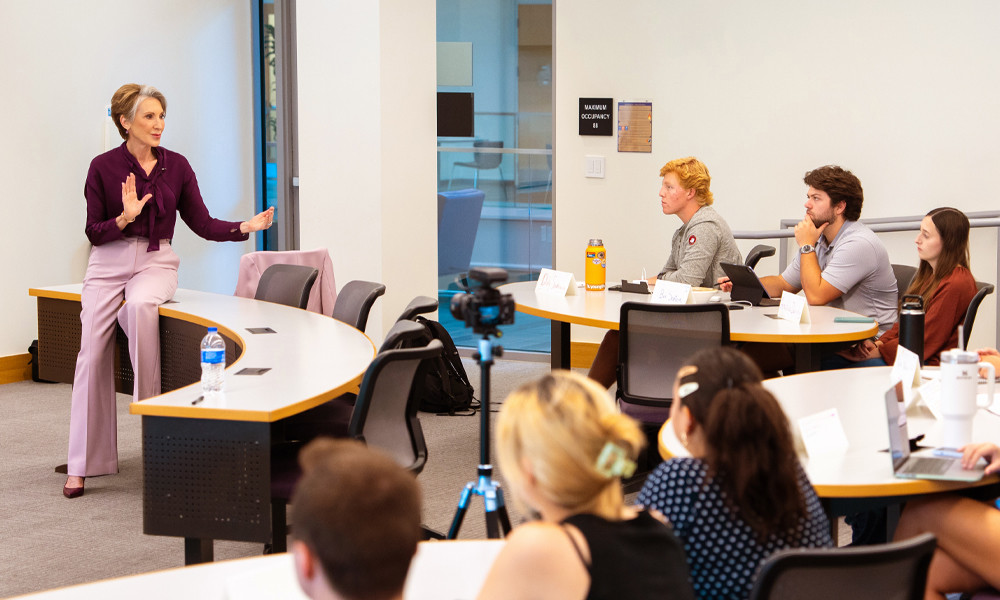A focus on producing results
News
SUMMARY: Business trailblazer and Board of Visitors member says the way to encourage creativity is to ‘measure it and reward it.’
Carly Fiorina—first woman to lead a Fortune 50 company, candidate for President of the United States in 2016 and a member of the James Madison University Board of Visitors—paid a visit to the JMU campus on Sept. 20 to deliver a speech keyed to the observance of Constitution Day.
Earlier in the day, Fiorina—who made history when she was named CEO of Hewlett-Packard Co. in 1999—was in Hartman Hall to respond to questions from MGT 320 instructor Cindi Reding and members of her class.
MGT 320 focuses on technological innovation as a primary source of competitive advantage for established firms as well as startups. In the class, students learn about the challenges business leaders face as they try to bring technological innovations to market. Topics covered include technology strategy, the psychology of discovery and invention, the entrepreneurial mindset, management of innovation processes and the protection of innovation.
The following are some excerpts from Fiorina’s informal remarks to the class.
Product innovation starts with creativity. How do you make sure that creativity is encouraged?
“The way to build a creative environment is to encourage it, measure it and reward it. Mistakes inevitably will be made. If I’m advising a company or CEO, and they say, ‘We want more risk-taking’ … the first question I always ask is ‘are you willing to tolerate more mistake-making?”
In a technology company, where do most of the ideas come from?
“A lot of innovations are responses to unsolved problems. If you want a creative, innovative environment, part of what that requires is asking people who are interacting with customers and competitors, ‘What are the problems you see that aren't getting solved by the products we have?’”
Did shareholders ever adjust to the idea of disruptive innovation, or were they always a thorn in your side?
“When I was a CEO we bemoaned the fact that the average holder of stock held onto it for five weeks. Now the average holder of stock holds onto it for maybe five milliseconds. That's important because it isn't a time-horizon that's realistic for any company—but particularly one engaged in innovation.”
Was it your strategy as a CEO to be the market leader, to be out there in front before anyone else? Or was it to wait-and-see first about marketplace acceptance?
“There are times when being a market leader absolutely makes the most sense ... on the other hand, there are times when being a ‘fast follower’ is a better strategy. The most important point is that you have to make a deliberate choice, and it needs to be made up-front.”
Do you have any personal experience that bears on the importance of decisiveness as a characteristic of CEOs?
“A leader needs to know when a decision must be made, and how much information is needed to make a good decision. The leader needs to take the time—make the time—to gather the information needed to decide in the way that's most productive. But we tend to view [Elon Musk-style executives] as business heroes. I guarantee you those people are making as many mistakes as good decisions. What you want is a high ratio of making the right decision.”
How do you manage a complex process like the 2001 merger of Hewlett-Packard and Compaq? The bringing together of two companies can go well, if there's good planning and the culture differences are addressed. Or it can go badly.
“Sometimes you'll hear people describe culture as ‘the soft stuff,’ but it's actually the hardest stuff of all. I would describe it as the software of a business. If a culture is wrong—if it doesn't fit your strategy—you're never going to achieve your objectives. And if a culture is right, you will leverage all of your assets.”
How do you overcome the skepticism of colleagues?
“I started out at the bottom of a huge company. But what I learned over and over and over again— including in that entry-level job—is that if you'll focus on producing results that matter, people will pay attention. It's one of the great things about business—results count."
What did it feel like the day you found out you were the first woman to be named CEO of a Fortune 50 company?
“I guess the best word I can use is ‘sobering.’ I knew that it was a very tall order, and that I would be gearing up for a very long, tough slog. It never occurred to me that people would focus on the fact that I was a woman. What I thought about was that I was the first outsider, I was the first non-engineer, I didn’t come from Silicon Valley. I wasn’t even from the computer industry.”
What advice would you give to women, and men, who aspire to the executive suite?
“There's nothing wrong with ambition. However, based on my own experience and the experience of watching others, your ambition should be to do the very best job you can with the job you've got. And people will pay attention. I have seen more people ruin their careers because they spent all their time thinking about what job they could get some day. And they didn't do the job they had.”
